Introduction
The Translantic Trade
Bookbinding in the Colonies
- Bookbinders in Annapolis
- Baltimore and Beyond
Credits
Special Collections
Guide to Government Records
Museum Online
The bookbinding trade in Annapolis began with the relocation of the seat of government in 1694. The state government needed new laws printed and bound, and lawyers, politicians, and merchants required blank and printed books for recordkeeping. Given the demand for these services, it was not surprising that local bookbinders began advertising their services in the Maryland Gazette of Annapolis.
 |
Advertisement for William Poultney SPECIAL COLLECTIONS (Maryland Gazette Collection) Jonas Green and William Rind, April 22, 1762, page 3, MSA SC 2731. In 1762 William Poultney (fl. Annapolis, second half of the eighteenth century) advertised himself as a bookbinder in the Maryland Gazette. His business was attached to the printing office of Jonas Green, the famous printer of the Maryland Gazette. The Green House still stands on Charles Street in Annapolis. |
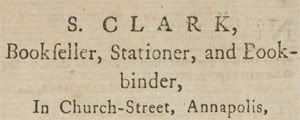 |
Advertisement for S. Clark SPECIAL COLLECTIONS (Maryland Gazette Collection) Frederick and Samuel Green, September 14, 1786, page 3, MSA SC 2731. The late eighteenth century and early nineteenth century advertisements in the Maryland Gazette suggest a lively coming and going of bookbinders, stationers, printers and booksellers offering various types of printed materials and services. In Annapolis Stephan Clark sold and bound books from at least 1784 to the early 1800s, and managed an important local lending library. |
 |
 |
| Payment to Frederick Green, October 31, 1780 TREASURER OF THE WESTERN SHORE (Journal of Accounts), 1780, page 23, MSA S606-1. | Payment to William S. Green, October 23, 1806 GOVERNOR AND COUNCIL (Orders on the Treasury), 1799-1812, r17, MSA S1092-1. |
William and Frederick Green, sons of the printer Jonas Green, offered an array of bookbinding services in Annapolis. The brothers bound laws and debt books for the state government, to enable new laws to be circulated throughout the state. Governmental accounting records document regular payments to William and Frederick for their services as bookbinders from the 1780s to the 1810s. In their own small way, bookbinders like the Green brothers used their trades to support the work of city and state governments.
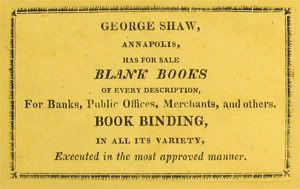 |
 |
| Binder's Ticket from George Shaw of Annapolis Binding: SPECIAL COLLECTIONS (Willman Spawn Collection), MSA SC 5797-1-175. Original contents: GOVERNOR AND COUNCIL (Letterbook), 1817-1834, v. 1, MSA S1075-13. |
Front cover decoration detail Binding: SPECIAL COLLECTIONS (Willman Spawn Collection), MSA SC 5797-1-175. Original contents: GOVERNOR AND COUNCIL (Letterbook), 1817-1834, v. 1, MSA S1075-13. |
George Shaw (d. 1829) was the youngest son of the famous Annapolis cabinetmaker, John Shaw. Trained as a furniture-maker, George worked as a bookseller in Annapolis from 1814 to 1817 before returning to work as a cabinetmaker. This leather-bound book, sold by George Shaw, is characterized by its fine craftsmanship, elegant proportions, and simple ornament. Although it is not possible to link the creation of this book to George Shaw, his discerning taste as a book dealer is evident in the fine craftsmanship, elegant proportions, and simple ornament that characterizes this book.
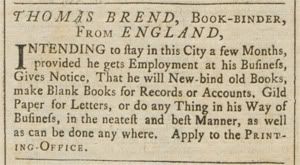
Advertisement for Thomas Brend
Maryland Gazette, July 19, 1764, page 2
MSA SC 2731
Two years after William Poultney advertised in the Maryland Gazette, English-born bookbinder Thomas Brend (fl. 1764-1800) published a trade notice for his services in Annapolis. Brend left Annapolis in 1766 to work as a bookbinder in Williamsburg, Virginia. In the 1790s he bound books for the personal library of Thomas Jefferson, and was nicknamed "the unhurried binder" because of the great length of time it took him to finish his bindings.
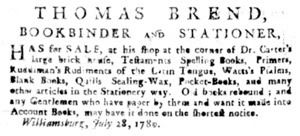
Advertisement for Thomas Brend
Virginia Gazette, August 19, 1780, page 2
Courtesy: Colonial Williamsburg Foundation
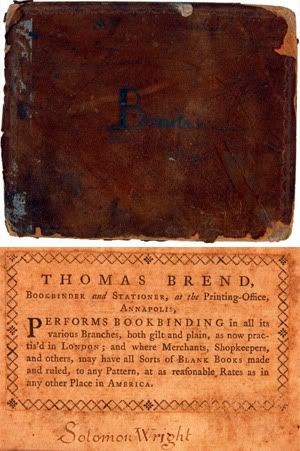 |
Binding by Thomas Brend Binding: Queen Anne's County Court (Census of 1778), 1778, inside front endsheet and back cover, MSA C 1365-1 Original contents: Willman Spawn Collection, MSA SC 5797-1-17 Thomas Brend bound this book of census records while he worked in Annapolis between 1764 and 1766. Although the binder's ticket means that the book was made between 1764 and 1766, the earliest entry in the book indicates that it was not used until 1778. Solomon Wright, a lawyer from Queen Anne's County, Maryland, and a member of the Queen Anne's County delegation at the Constitutional Convention of 1776, signed this book. During the Revolutionary War he was appointed to try people for treason on Maryland's Eastern Shore. Notes and scribbles, like those by Wright written in this book, give historians valuable pieces of information that may not be preserved anywhere else. |
The use of any username and password on our site is for personal and educational purposes only, and constitutes agreement to abide by any and all copyright restrictions. In most instances the username aaco and password aaco# will work. Contact msa.helpdesk@maryland.gov if you have any questions or have difficulty accessing files.
Tell Us What You Think About the Maryland State Archives Website!
[ Archives' Home Page || All About Maryland || Maryland Manual On-Line || Reference & Research
|| Search the Archives || Education & Outreach || Archives of Maryland Online ]Governor || General Assembly || Judiciary || Maryland.Gov
Designed and produced by R. M. Bartgis
Copyright November, 2010 Maryland State Archives